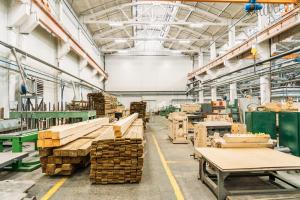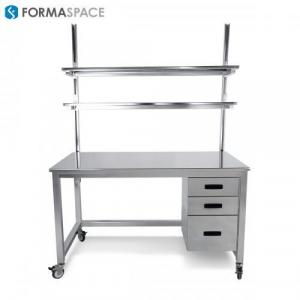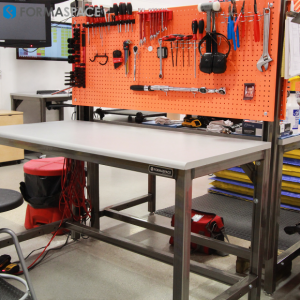
Could Raw Material Supply Shortages Slow Down the Economic Recovery?
Read more about what are the recent shortages of raw materials affecting the furniture manufacturing and construction industries.
But soon afterward, we began to hear from supply chain managers that, yes, while chips were indeed in critically short supply, the bigger story was that, in the words of one manufacturing exec in the Midwest, “chips were an easy scapegoat – it’s not just chips, everything in the supply chain is jammed up now.”
So what are the main reasons that many raw materials are in short supply, and when will things return to normal?
We decided to focus on what is happening with material supplies in our industry, furniture manufacturing, to see what is going on and how supplies might ease up in the coming months.
But first, here is a useful tip: if you are contemplating a new order, talk to your Formaspace Design Consultant now about placing your order earlier than usual to avoid the impact of longer lead times for some materials. And if you are flexible on material choices, your Design Consultant can also advise you on which material options have shorter lead times.
Steel And Other Metal Raw Materials
Here at our factory headquarters in Austin, Texas, we use a lot of carbon steel to fabricate the famous heavy-duty frames found in all Formaspace workbenches, tables, workstations, and desks.
We also source a lot of stainless steel for making furniture destined for settings such as cleanrooms, laboratories, as well as hospitality settings, such as food service kitchens.
As part of our Made-in-America manufacturing philosophy, we use locally sourced steel and other metals, which gives us a significant lead time advantage over other manufacturers that are reliant on overseas metal suppliers.
Nonetheless, there is increasing pressure on steel and other metal supply chains overall due to production cutbacks during the pandemic, which let inventory levels fall off significantly.
As a result, many steel mills and aluminum foundries and mills – especially those in overseas locations where vaccination rates are still very low – are struggling to reboot production levels to keep up with rapidly increasing demand.
US tariffs on foreign steel and metal imports, first introduced by the Trump administration to encourage American steel manufacturing, are still in place. The tariffs have given domestic metal manufacturers increased pricing power.
For example, the CRU Index for carbon steel, a widely-used benchmark from the Commodities Research Unit (CRU), which tracks the future commodity prices of Hot-Rolled Coil Steel (HRC) produced in the Midwest, has leaped from around $450 a ton last year to around $1,650 this month – a 360% increase.
Reasons For Concern
- Prices for raw metal materials are way up, hot-rolled coil steel (used in extruded frames, for example) is up 360% compared to last year.
- Demand for metals bottomed out during 2020 due to low demand, causing mills and foundries to cut production. But demand has returned, creating major shortages.
- Many overseas mills and foundries are still experiencing high levels of Covid infections among their populations, which is slowing a return to full production capacity.
- US tariffs on imported metal products keep overall metal prices higher in the US.
- Demand for metal products is also rising due to increased construction activity. If the proposed Infrastructure Bill is passed, demand for metals used in bridges, wiring, etc. will increase further.
- Other metals not commonly used in furniture production, such as copper and lithium used in green energy projects, are also in short supply and could slow down efforts to build new green infrastructure projects to address climate change.
Reasons For Optimism
- Vaccination programs are helping protect workers in the US, Europe, and the UK, allowing their workforces to return to full strength.
- Higher prices are helping metals manufacturers restart factories to increase production, which should eventually lead to lower prices.
- The Biden administration may elect to ease US tariffs on imported metal products, which would reduce raw material prices for US manufacturers.
Engineered Materials And Laminates
Here at Formaspace, we offer our customers a wide variety of material options – even our so-called standard products can be customized by selecting among different work surface material options to meet the unique requirement of your application.
These material options include work surfaces made from high-pressure laminate (HPL); long-lasting engineered epoxy; durable, chemically-resistant phenolic resin; soft HDPE (to prevent scratching products); ESD protective surfaces (to prevent damaging sensitive microelectronic circuits); stainless steel (discussed earlier); and even maple hardwood surfaces (discussed in the next section on wood-based products).
Reasons For Concern
- Some work surface materials, such as epoxy countertops, are currently experiencing significantly longer lead times than normal – in some cases, twice as long as compared with April 2020.
Reasons For Optimism
- Production lead times should begin to drop as factories return to full-scale production and ease the backlog of orders.
- Talk to your Formaspace Design Consultant about placing your order early, as well as looking at material options to minimize lead times.
Wood-Based Raw Material Products
Compared to many furniture manufacturers, Formaspace (and our sister entity, Formaspace Contract, which creates custom solutions for the office, hospitality, and other related markets) does not use a significant amount of wood or wood-based raw materials in making furniture – we typically use heavy-duty steel to frame our furniture products.
The one exception is specialty woodwork surfaces, including our popular hardwood maple tops used in both office and industrial applications, or our bespoke hand-made desks, credenzas, and conference tables that feature unique custom wood selections, such as live-edge walnut.
This is in contrast with other furniture manufacturers (especially those making products for residential or hospitality markets) that may heavily rely on white pine, chipboard, or MDF materials that are hidden underneath upholstered or plastic laminated surfaces.
But it’s the adjacent construction market that is suffering the greatest impact from the overall shortage of dimensioned lumber and other wood and wood-based raw materials.
Construction industry analysts point to the sharp increase in lumber prices (especially plywood*) that is boosting the average cost of a new home by $36,000, according to the National Association of Home Builders.
According to researchers at North Carolina State University’s College of Natural Resources, the price of lumber hit an all-time high in May 2021 (at nearly $1,700 per thousand board feet), which is a 400% price increase compared to May 2020.
*Paying around $10 for a ½ inch sheet of plywood is a distant memory. Searching for a sheet of standard plywood today, the retail price at Home Depot is $22. According to US BLS statistics, the Producer Price Index cost of plywood dipped to 195 basis points in December 2019, in May 2021, it had jumped up by 200% to 392.
Why the big increase in wood prices?
Read more...
Julia Solodovnikova
Formaspace
+1 800-251-1505
email us here
Visit us on social media:
Facebook
Twitter
LinkedIn
EIN Presswire does not exercise editorial control over third-party content provided, uploaded, published, or distributed by users of EIN Presswire. We are a distributor, not a publisher, of 3rd party content. Such content may contain the views, opinions, statements, offers, and other material of the respective users, suppliers, participants, or authors.




